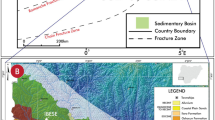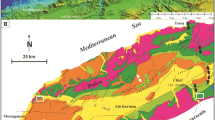Abstract
On the basis of a newly-constructed record of magnetic susceptibility (SUS) and the depositional rate change of eolian loess-red clay sequences in the last 7.2 Ma BP from the hea Plateau, together with a cornperison of a record of °18O values from the equatorial East Pacific Ocean and eolian Quartz flux variations fmm the North Pacific Ocean, the evolutiomuy process of the Late Cenozoic Great Glaciation in the Northern Hemisphere can be divided into three stages: the arrival stage around 7.2–3.4 Ma BP, the initial stage at about 3.4—2.6 Ma BP, and the Great Ice Age since 2.6 Ma BP. The evolution of the East Asian monsoon is characterized by paid winter and summer monsoons, and it is basically composed of the initial stage of weak winter and summer monsoons, the transitional stage of simultaneous increase in intensity of winter and summer monsoons, and the prevailing stage of strong winter and week summer monsoons, or weak winter and strong summer monsoons. The Late Cenowic global tectonic uplift, paaicdarly the Qinghai-Xizang Plateau uplift and the associated CO2 concentration variation, controls the dng processes of the onset of Great Glaciation and the long-term changes of East Asian monsoom climate in the Northern Hemisphere to a large extent. The accelerating uplift of the Qinghai-Xizang Plateau between 3.4 and 2.6 Ma BP provided an important driving force to global climiatic change.
Similar content being viewed by others
References
Ruddiman, W. F., Kutzbach, J. E., Forcing of Late Cenozoic Northern Hemisphere climate by plateau uplift in southern Asia and the American West,Journal of Geophysical Research, 1989, 94(D15): 18409.
Ruddiman, W. F. ((ed.),Tectonic Uplift and Climate Change, New York: Plenum Press, 1997, 1–515.
An Zhisheng, Liu Tungsheng, Lu Yanchou et al., The long-term paleomonsoon variation recorded by the loess-paleosol sequence in central China,Quaternary Internatwnal, 1990, 7/8: 91.
Liu Tungsheng ((ed.),Loess and Environment (in Chinese), Beijing, Science Press, 1985, 1–481.
Wu Xihao, An Zhisheng, Loess-paleosol sequence on the Loess Plateau and the uplift of Qinghai-Xizang Plateau,Science in China, Ser. D, 1996, 39(2): 121.
Sun Donghuai, Liu Tungsheng, Chen Mingyang et al. Magnetic stratigraphy of red clay sequence of Loess Plateau of China and climate change,Science in China (in Chinese), Ser. D, 1997, 27(3): 265.
Ding Zhongli, Sun Jimin, Zhu Rixiang et al., The origin of red clay from the Loess Plateau and Late Pliocene aridification of North China, Quatenuuy Sciences (in Chinese with English abstract), 1997. (2): 147.
Sun Donghuai, Chen Mingyang, Shaw, J. et al., Magnetostratigraphy and paleoclimatic record of Late Cenozoic eolian sequences on the Loess Plateau,Science in China (in Chinese), Ser. D, 1998, 28(1): 79.
Shackleton, N. J., Hall, M. A., Pate, D., Pliocene stable isotope shatigraphy of site 846, inPmcdmgd of the Ocean Drilling Program, Scientific Results (eds. Pisias, N. G. et al.). College Station TX: Ocean Drilling Program, 1995, 138: 227.
Kukla, G., An Zhisheng, Loess stratigraphy in central China,Paleogeopaphy, Plaeoclimatology, Pahomology, 1989, 72(2): 203.
Chen Xiaofeng, Stratigraphy and large mammals of the “Jinlean” stage, Shanxi, China, Qwtemwy Sciences (in Chinese with English abstract), 1994, (4): 339.
Kennett, J.P., Cenozoic evolution of Antarctic glaciation, the circum-Antarcitc Ocean and their impact on global paleoceanog-raphy,Jod of Geophysical Research, 1977, 82(27): 3843.
Zachos, J. C., Lohmann, K. C., Walker, J. C. G., Abrupt climate change and transient climates during the Palm: a marine perspective,The Journal of Geology, 1993, 101: 191.
Mangerud, J., Jansen, E., Landvik, J. Y., Late Cenozoic history of the Scandinavian and Barents Sea ice sheets,Global and Phetcq Change, 1996, 12: 11.
Larsen, H. C., Saunders, A. D., Clift, P. D. et al., Seven million years of glaciation in Greenland.Science, 1996, 264: 952.
McDougall, I., Wensink, H., Paleomagnetism and geochronology of the Pliocene-Pleistocene lavas in Iceland,Earth Planet. Sei. Lett., 1966, 1: 232.
Curry, R. R., Glaciation about 3 00 000 years ago in the Sierra Nevada,Science, 1966, 154: 770.
Wu Xihao, Li Yongzhao, Moraines and environments in Qinghai-Xkang Plateau,Quaternary Scienas (in Chinese with English abstract), 1990, (2): 146.
Shackleton, N. J., Opdyke, N. D., Oxygen isotope and palammagnetic evidence for early Northern Hemisphere glaciation,Nature, 1977, 270: 216.
Cande, S. C., Kent, D. V., Revised calibration of the geomagnetic polarity time scale for the late Getaeeous and Cemic,Journal of Geophysical Research, 1995, 100: 6093.
Leinen, M., Heath, G. R., Sedimentary indicators of atmospheric activity in the Northern Hemisphere during the Cenozoic,Palaeography, Palacoclimatology, Palaeoecology, 1981, 36: 1.
Wu Xihao, Wang Fubao, An Zhisheng et al., Uplift stage and elevation of Tibet Plateau over the late Gnomic, inLoess Quaternary Geology and Global Change (in Chinese) ((eds. Liu Tungsheng, An Zhisheng), Beijing: Science Press, 1992, 1–13.
Wu, Xihao, A preliminruy study on the uplift amplitudes of Qinghai-Xizang Plateau, inLoess Quaternary Geology, Global Change (in Chinese) (eds. Liu Tungsheng, An Zhisheg, Wu Xihao), Beijing: Science Resa, 1996, 1–17.
Tao Junrong, Du Naiqiu, Miocene flora from Markam County and fossil record of Betulaceae,Acta Botanica Sinica (in Chinese), 1987, 29(6): 649.
Qian Fang, Preliminary study of horizontal tectonic movement in Arli, Tibet since Pliocene using pateomagnetic stratigraphy technique, inPetrospheric Tectonic Ewlution of Himalaya and Qinghai-Xizang Geophysics (in Chinese), Beijing: Geological Publishin House, 1990, 198–206.
Wang Fubao, Li Shengfeng, Shen Xuhui et al., Formation, evolution and environmental changes of the Gyirong Basin and upliit of the Himalaya,Science in China, Ser. D, 1996, 39(4): 401.
Burbank, D. W., Johnson, G. D., Intermontane-basin development in the past 4 Myr. in the north-west Himalaya,Nature, 1982, 298: 432.
Chen Huahui, Lin Xiulun, Guan Kangnian et al., Early Pleistocene deposite and its lower boundary (Q/N) in Tianshan Mt., Xinjiang region,Quatenary Sciences (in Chinese with English abstract), 1994, (1): 38.
Wu Xihao, Zhu Yizhi, The Neotectonic framework of the boundary of the Qinghai-Xizang Plateau, inProceedings of the First Symposium on Qinghai-Xizang Plateau (in Chinese) (ed. CGQXP Editorial Committee), Beijing: Science F’ress, 1992, 272–279.
Wu Xihao, Qian Fang, Pu Qinyu, Quaternary glaciogeology of East Kunlun Mts, inContribution to the Geology of Tibet Plateau (4) (in Chinese) (ed. CGQXP edition committee), Beijing: Geological Publishing House, 1982, 1–18.
Qian Fang, Zhang Jinqi, Study on the magnetic stratigraphy of the Qiangtang Formation and the neotectonism,Jounurl of Geomechnics (in Chinese with English abstract), 1997, 3(1): 50.
Fan Xiaomin, Li Jijun, Zhu Junjie et al., Cenozoic stratigraphic dating and subdivision of Lingxia Basin, Gansu Province,Chinese Science Bulletin, 1997, 42(14): 1457.
Li Jijun, Fang Xiaomin, Ma Haizhou et al., Geomorphologic and environmental evolution in the upper reaches of the Yellow River during the Late Cenozoic,Science in China, Ser. D, 1996, 39(4): 380.
Qian Fang, Xu Shujin, Chen Fubin et al., Study on the paleornagnetism of the Xigeda Formation,Mountain Research (in Chinese with English abstract), 1984, 2(4): 275.
Qian Fang, The Gravel chronology and environment of Gongba Formation in Dingri, Tibet, inQuuternary Glacial and Ervironment in the Western China (in Chinese) (ed. Chinese Quatemary Glacial and Environmental Center, the Commission of Chinese Quaternary), Beijing: Science Press, 1991, 285–291.
Chen Jie, Lu Yanchou, Ding Guoyu, Subdivision of Quatemary tectonic movement of west part of Qilian Mountain and Jiuxi Basin,Quaternury Sciences (in Chinese with English abstract), 1996, (3): 263.
Li Binyuan, Wang Fubao, Zhang Qinsong et al.,Quaternary Geology in Xizang (in Chinese), Beijing: Science Press, 1983, 110–171.
Zhang Rongzu, Zhen Du, Yang Qinye,Natural Geography of Xizang (in Chinese), Beijing: Science Press, 1982, 1–178.
Shi Ning, Cao Jiaxin, Kongsson, L. K., Late Cenozoic vegetation history and the Pliocene-Pleistocene boundary in the Yushe Basin, SE Shanxi, China,GRANA, 1993, 32: 260.
Nanjing Institute of Geography and Lake,Fault Lake Deposition and the Environment in Yunun (in Chinese), Beijing: Science Press, 1989, 16–53.
Tong Guobang, Zhang Junpai, Liu Minjian et al., Palaeovegetation (2—3 Ma BP) and lower boundary of Quaternary in Weihe River Basin, Shanxi,Marine Geology &Quutemary Geology (in Chinese with English abstract), 1989, 9(4): 86.
Wu Xihao, Qian Fang, Lan Chaoyu, Paleoclimatic reconstruction during the early Pleistocene, in Yanqing basin, Beijing, inLoess Quaternary Geology, Global Change (in Chinese) (ed. Liu Tungsheng), Beijing: Science Press, 1990, 47–61.
Kutzbach, J. E., Guetter, P. J., Ruddiman, W. F. et al., Sensitivity of climate to Late Cenozoic uplift in Southern Asia and the America West: numerical experiments,Journal Geophysical Research, 1989, 94(D15): 18–393.
Zhong Dalai, Ding Lin, Rising process of the Qinghai-Xizang (Tibet) Plateau and its mechanism,Science in China, Ser. D, 1996, 39(4): 369.
Wu Xihao, An Zhisheng, Some considerations of the Quatemary environmental dynamics of Qinghai-Tibetan and Loess Plateaus, inQinghai-Tibetan Plateau and Global Variations (in Chinese), Beijing: Meteorological Press, 1995, 222–227.
Author information
Authors and Affiliations
Additional information
Project supported by the foundation of Chinese Academy of Sciences (Grant No. KZ951-A1-402), the State Science and Technology Committee (Grant No. 95-pre-40)and the Chinese Nature Science Foundation (Grant No. 49672140)
Rights and permissions
About this article
Cite this article
An, Z., Wang, S., Wu, X. et al. Eolian evidence from the Chinese Loess Plateau: the onset of the Late Cenozoic Great Glaciation in the Northern Hemisphere and Qinghai-Xizang Plateau uplift forcing. Sci. China Ser. D-Earth Sci. 42, 258–271 (1999). https://doi.org/10.1007/BF02878963
Received:
Issue Date:
DOI: https://doi.org/10.1007/BF02878963




